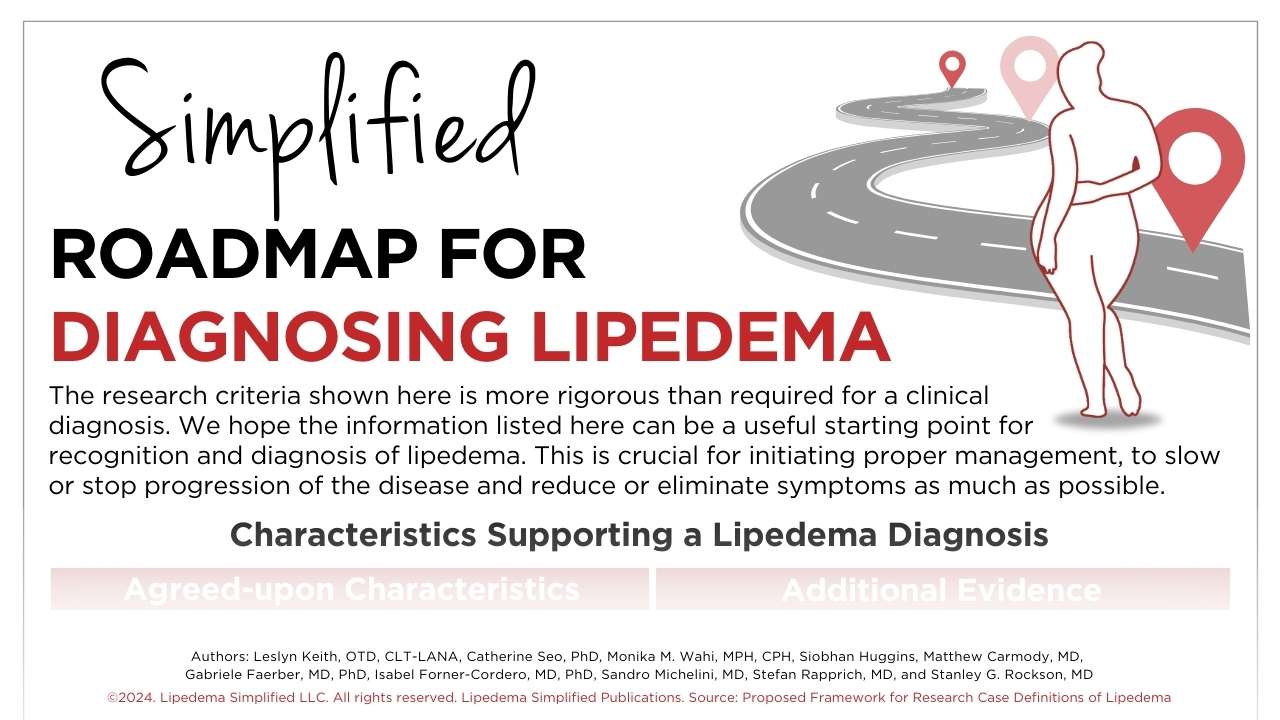Roadmap for Diagnosing Lipedema
In a groundbreaking development, the Lipedema Project has published a proposed framework for research case definitions of lipedema in Lymphatic Research and Biology Volume 22, Number 2. This open-access paper is a significant step towards modernizing the field of lipedema research and creating a robust platform for diagnosing millions of women with this disease. We invite researchers, clinicians, patients, and the general public to read the paper and delve into this crucial advancement.
The Essence of a Case Definition
A case definition delineates the essential components required to define a disease. For research purposes, it answers two pivotal questions: How do we know an individual is suitable for participation in a study on lipedema? And how do we determine when someone isn’t? In other words, it helps us confidently identify individuals with lipedema for study purposes.
This clarity is crucial when researching a disease like lipedema, which shares overlapping symptoms with other conditions despite differing underlying mechanisms. By ensuring that study subjects genuinely have lipedema, we enhance the validity of our research findings. It also ensures that control group individuals do not inadvertently have lipedema, thus maintaining the integrity of our research groups.
The Importance of Case Definitions in Lipedema Research
The accurate identification of lipedema is vital for several reasons. Firstly, it helps differentiate lipedema from conditions like constitutional obesity, aiding in understanding the root causes of the disease. Secondly, consistent data collection aligned with a standard case definition allows the lipedema research community to verify that studies are providing insights into the same disease. This consistency is crucial for performing meta-analyses, where data from multiple independent studies are integrated to offer comprehensive insights.
Implications for Diagnosis and Treatment
While the primary intention of the proposed framework is for research, it also holds significant potential for clinical application. The thorough explanations and evaluation methods detailed in the paper can assist skilled clinicians in recognizing and potentially diagnosing lipedema or referring patients to the appropriate specialists. Although research case definitions are typically more stringent than diagnostic criteria, this framework offers valuable entry-level information for clinicians interested in lipedema.
The Proposed Framework: Agreed-Upon Characteristics and Additional Evidence
Our framework is divided into two categories: Agreed-Upon Characteristics and Additional Evidence.
Agreed-Upon Characteristics
These are features widely accepted by the lipedema research community as key identifiers of the disease. They include:
- Female sex
- Pain and/or sensitive fat
- Disproportionate fat between limbs (more fat) and torso (less fat)
- Tissue changes (i.e. stiff, bumpy and/or dimpled fat)
- Fat in arms and/or lower body is non-responsive to low-calorie diet and exercise
Additional Evidence
This category includes features that may vary among individuals due to comorbidities or specific management interventions. Further research is needed to confirm their validity and reliability in diagnosing lipedema. Examples include:
- Fat abruptly ends at the wrist and/or ankles
- Swelling without foot/hand involvement
- Starts or worsens with hormonal flux such as puberty, pregnancy, perimenopause
- Leg shape/size looks like other family members
- Easy bruising without apparent cause
Practical Application of the Case Definition
To diagnose lipedema, we cluster agreed-upon characteristics and additional evidence. Here are the criteria:
- Female sex and pain/heightened sensitivity, plus all three remaining agreed-upon characteristics (disproportionate adipose tissue distribution, skin/tissue changes, unresponsiveness to diet).
- Female sex and pain/heightened sensitivity, plus two other agreed-upon characteristics and two additional evidence characteristics.
- Female sex and pain/heightened sensitivity, plus one other agreed-upon characteristic and four additional evidence characteristics.
This structured approach ensures a comprehensive and accurate diagnosis of lipedema.
The Living Document
We consider this framework a living document, open to revisions as our understanding of lipedema evolves. We encourage readers to engage with the paper, provide feedback, and suggest improvements. This global collaborative effort aims to generate stronger lipedema research, amalgamating data from teams worldwide to better understand and assist those with the disease.
Conclusion
The publication of the proposed framework for research case definitions of lipedema marks a significant milestone in lipedema research. By standardizing the identification of lipedema, we can enhance the quality and consistency of research, ultimately providing better answers for clinicians and patients. We invite you to read the paper, share your thoughts, and join us in this collaborative effort to advance lipedema research. For any questions or comments, please reach out to us at Lipedema Project: [email protected].
Thank you for your interest and support in this crucial endeavor. Together, we can make strides in understanding and addressing lipedema, offering hope and improved outcomes for millions affected by this condition.
Fill out the form below to download the printable version of the one-pager roadmap.

